#traditional data centers
Explore tagged Tumblr posts
Text
Traditional Data Centers vs. Cloud: Navigating the Digital Infrastructure Landscape
Introduction -
Businesses must continually make important decisions on their IT infrastructure in the quickly changing world of technology. Making the decision to switch to cloud computing solutions or remain in traditional data centres is one of the biggest decisions they face. Making an informed decision requires a grasp of the subtle differences between the two possibilities, each of which has advantages and disadvantages.
Traditional Data Centers: The Tried and Tested Workhorses
Enterprise IT infrastructures have traditionally been supported by traditional data centres. These on-premises facilities are located within an organization's walls and contain physical servers, storage arrays, networking hardware, and cooling systems.
Pros:
Control and Security: With data stored on-site, organizations have full control over security measures and compliance protocols, ensuring data sovereignty and confidentiality.
Predictable Performance: By managing their own hardware and software stack, organizations can fine-tune performance according to their specific requirements, ensuring consistent and predictable levels of performance.
Compliance: Traditional data centres enable organizations to adhere to industry-specific compliance regulations by keeping sensitive data within their premises, ensuring compliance with data protection laws.
Cons:
Capital Expenditure: A traditional data centre's construction and upkeep involve a large initial infrastructure investment, which covers hardware acquisition, setup fees, and continuing maintenance expenditures.
Scalability Challenges: It can be difficult and time-consuming to scale traditional data centres to handle increasing workloads or unexpected demand spikes; new hardware purchases and infrastructure modifications are frequently needed.
Maintenance overhead: The daily administration, upkeep, and troubleshooting of an organization's data centre infrastructure is their responsibility. This can be a resource-intensive task that takes time away from important company operations.
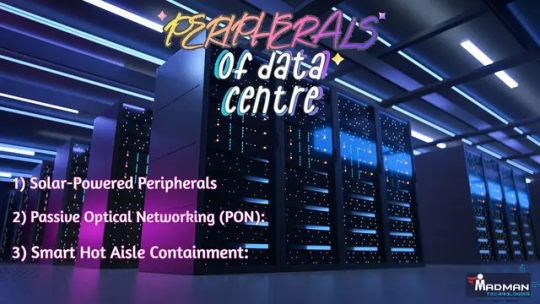
Cloud Computing: The Game-Changer in IT Infrastructure
Cloud computing, which provides on-demand scalability, flexibility, and cost-efficiency, has completely changed how businesses use and manage IT resources. Numerous services, such as Infrastructure as a Service (IaaS), Platform as a Service (PaaS), and Software as a Service (SaaS), are accessible through cloud solutions. These are the main advantages and difficulties:
Pros:
Scalability and Flexibility: Cloud computing allows organizations to scale resources up or down dynamically in response to changing demand, enabling optimal performance and cost-efficiency.
Cost Savings: Cloud solutions operate on a pay-as-you-go model, eliminating the need for upfront capital expenditure and enabling organizations to pay only for the resources they consume, resulting in cost savings and improved financial predictability.
Agility and Innovation: Cloud computing accelerates innovation by providing access to a vast array of services, tools, and technologies that enable rapid development, deployment, and iteration of applications.
Cons:
Security and Compliance Concerns: Entrusting sensitive data to third-party cloud providers raises concerns about data security, privacy, and compliance with industry regulations, necessitating robust security measures and compliance certifications.
Vendor Lock-In: Depending heavily on a single cloud provider may lead to vendor lock-in, limiting organizations' flexibility and portability between different cloud platforms.
Performance and Latency: Cloud solutions rely on internet connectivity, which may introduce latency and performance issues, particularly for applications with stringent latency requirements or data sovereignty concerns.

Making the Right Choice for Your Business
In the end, several variables, such as the organization's budget, performance requirements, scalability demands, and compliance obligations, will determine whether traditional data centres or cloud computing is preferable. Many businesses use a hybrid strategy, combining cloud and on-premises resources to strike the best possible balance between cost, scalability, and control. You may make well-informed judgments that promote innovation, efficiency, and growth in the digital age by comprehending the advantages and disadvantages of each strategy and matching them with your company's aims and objectives.
In conclusion, a variety of criteria, such as the organization's budget, performance requirements, scalability needs, and compliance duties, influence the decision between traditional data centres and cloud alternatives. Scalability, flexibility, and cost-effectiveness are offered by cloud solutions, while control and security are provided by traditional data centres. Many businesses use a hybrid strategy, combining cloud and on-premises resources to strike the best possible balance between cost, scalability, and control. In the end, choosing the best IT infrastructure plan to support corporate growth and innovation in the digital age depends on knowing the particular requirements of the company.
Additionally, numerous people can view the data simultaneously thanks to this technology. This expedites and simplifies work. You may handle your data in real-time from any remote part of the world with the help of Madman Technologies, they are the best Cloud Computing and DC migration services in India.
You can google our website and contact us over the phone — [email protected]
Contact details — 9625468776
#cloud services#cloud computing#it services#information technology#it sector#it company#traditional data centers#it products#itservices#technology#it technology#it solutions#artificial intelligence#video conferencing#wifi#data center#information consultancy#cloudcomputing
0 notes
Text
All-Star Moments in Space Communications and Navigation
How do we get information from missions exploring the cosmos back to humans on Earth? Our space communications and navigation networks – the Near Space Network and the Deep Space Network – bring back science and exploration data daily.
Here are a few of our favorite moments from 2024.

1. Hip-Hop to Deep Space
The stars above and on Earth aligned as lyrics from the song “The Rain (Supa Dupa Fly)” by hip-hop artist Missy Elliott were beamed to Venus via NASA’s Deep Space Network. Using a 34-meter (112-foot) wide Deep Space Station 13 (DSS-13) radio dish antenna, located at the network’s Goldstone Deep Space Communications Complex in California, the song was sent at 10:05 a.m. PDT on Friday, July 12 and traveled about 158 million miles from Earth to Venus — the artist’s favorite planet. Coincidentally, the DSS-13 that sent the transmission is also nicknamed Venus!

NASA's PACE mission transmitting data to Earth through NASA's Near Space Network.
2. Lemme Upgrade You
Our Near Space Network, which supports communications for space-based missions within 1.2 million miles of Earth, is constantly enhancing its capabilities to support science and exploration missions. Last year, the network implemented DTN (Delay/Disruption Tolerant Networking), which provides robust protection of data traveling from extreme distances. NASA’s PACE (Plankton, Aerosol, Cloud, ocean Ecosystem) mission is the first operational science mission to leverage the network’s DTN capabilities. Since PACE’s launch, over 17 million bundles of data have been transmitted by the satellite and received by the network’s ground station.
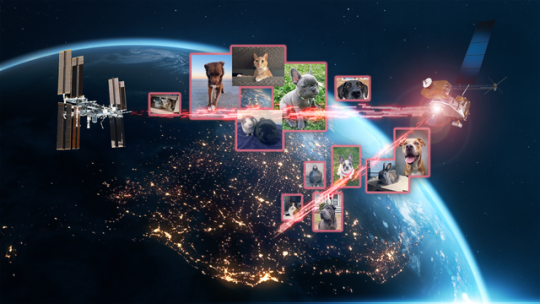
A collage of the pet photos sent over laser links from Earth to LCRD and finally to ILLUMA-T (Integrated LCRD Low Earth Orbit User Modem and Amplifier Terminal) on the International Space Station. Animals submitted include cats, dogs, birds, chickens, cows, snakes, and pigs.
3. Who Doesn’t Love Pets?
Last year, we transmitted hundreds of pet photos and videos to the International Space Station, showcasing how laser communications can send more data at once than traditional methods. Imagery of cherished pets gathered from NASA astronauts and agency employees flowed from the mission ops center to the optical ground stations and then to the in-space Laser Communications Relay Demonstration (LCRD), which relayed the signal to a payload on the space station. This activity demonstrated how laser communications and high-rate DTN can benefit human spaceflight missions.

4K video footage was routed from the PC-12 aircraft to an optical ground station in Cleveland. From there, it was sent over an Earth-based network to NASA’s White Sands Test Facility in Las Cruces, New Mexico. The signals were then sent to NASA’s Laser Communications Relay Demonstration spacecraft and relayed to the ILLUMA-T payload on the International Space Station.
4. Now Streaming
A team of engineers transmitted 4K video footage from an aircraft to the International Space Station and back using laser communication signals. Historically, we have relied on radio waves to send information to and from space. Laser communications use infrared light to transmit 10 to 100 times more data than radio frequency systems. The flight tests were part of an agency initiative to stream high-bandwidth video and other data from deep space, enabling future human missions beyond low-Earth orbit.

The Near Space Network provides missions within 1.2 million miles of Earth with communications and navigation services.
5. New Year, New Relationships
At the very end of 2024, the Near Space Network announced multiple contract awards to enhance the network’s services portfolio. The network, which uses a blend of government and commercial assets to get data to and from spacecraft, will be able to support more missions observing our Earth and exploring the cosmos. These commercial assets, alongside the existing network, will also play a critical role in our Artemis campaign, which calls for long-term exploration of the Moon.

On Monday, Oct. 14, 2024, at 12:06 p.m. EDT, a SpaceX Falcon Heavy rocket carrying NASA’s Europa Clipper spacecraft lifts off from Launch Complex 39A at NASA’s Kennedy Space Center in Florida.
6. 3, 2, 1, Blast Off!
Together, the Near Space Network and the Deep Space Network supported the launch of Europa Clipper. The Near Space Network provided communications and navigation services to SpaceX’s Falcon Heavy rocket, which launched this Jupiter-bound mission into space! After vehicle separation, the Deep Space Network acquired Europa Clipper’s signal and began full mission support. This is another example of how these networks work together seamlessly to ensure critical mission success.

Engineer Adam Gannon works on the development of Cognitive Engine-1 in the Cognitive Communications Lab at NASA’s Glenn Research Center.
7. Make Way for Next-Gen Tech
Our Technology Education Satellite program organizes collaborative missions that pair university students with researchers to evaluate how new technologies work on small satellites, also known as CubeSats. In 2024, cognitive communications technology, designed to enable autonomous space communications systems, was successfully tested in space on the Technology Educational Satellite 11 mission. Autonomous systems use technology reactive to their environment to implement updates during a spaceflight mission without needing human interaction post-launch.

A first: All six radio frequency antennas at the Madrid Deep Space Communication Complex, part of NASA’s Deep Space Network (DSN), carried out a test to receive data from the agency’s Voyager 1 spacecraft at the same time.
8. Six Are Better Than One
On April 20, 2024, all six radio frequency antennas at the Madrid Deep Space Communication Complex, part of our Deep Space Network, carried out a test to receive data from the agency’s Voyager 1 spacecraft at the same time. Combining the antennas’ receiving power, or arraying, lets the network collect the very faint signals from faraway spacecraft.
Here’s to another year connecting Earth and space.
Make sure to follow us on Tumblr for your regular dose of space!
1K notes
·
View notes
Text
Cologne // Tim Drake x GN! Reader
hay guys! where Tim Drake and Red Robin (ur bodyguard for the time being) smell suspiciously the same— it’s like you can’t even tell the difference! no angst, this took me so long oh my goodness i’m gonna stick to writing what i know. stay tuned for hurt/angst i have a lot of grievances to spit out! not proofread.
Part 2
—
Gotham was the last place you’d expected to be sent off to, but it’s where you found yourself now. Despite being disgustingly crime ridden, it was the center of trade, commerce, business, and more importantly— information. Which is precisely what you’d been sent to offer.
Your family’s company recently made a ground breaking discovery in pharmaceuticals, creating a drug that could limit the spread of cancer cells without traditional side effects; YB-V they called it. However, the by-product of production was much more severe, resulting in a chemical compound capable of mutating all the cells in a person completely to become something other as if they belonged to a different entity. Given the right motivations and means, the cells could be manipulated by a third party, turning them into fully conscious puppets of some sort.
With data leaks and security concerns, and the serious nature of the consequences if your drug had fallen into the wrong hands, you were sent to deliver the research and development to the production team personally; placed in charge of overseeing production until launch.
Which all sounded good in theory, but as you found yourself twiddling your thumbs in a blacked out office space, getting briefed on the gravity of the situation by a police task force with some vigilante character hanging around behind you, you began to question what it was all worth.
“So let me get this straight, an email between Wayne Corp and ourselves was leaked and now a couple big shot villains want to steal it? What kind of bad guy reads emails?”
A burly officer with a thick white mustache and a pair of square set glasses cleared his throat awkwardly, “That’s correct.”
“Some tech team,” you scoffed. “I’m the only one that can access any of the files, it’s all biometrically locked. While this certainly puts a damper on my day, we should be able to proceed normally.”
“They have your identity too,” the figure in the back voiced. Red Robin, you’d been informed, one of Gotham’s crime fighters in spandex (allegedly.) Up until now he hadn’t spoken a word, loitering while the police explained everything to you.
“Which is why we brought you here,” the commissioner pipped, reaching for his coffee mug as he spoke. “Red Robin has agreed to watch over your activities for the duration of your time in Gotham. For your safety, and ours.”
Have this guy tail you? As if. You were occupied enough without having a stranger watch your every move. A vigilante at that, it’s not like you could look at his resume and review his history.
“While that is a gracious offer, I have my own bodyguards. They’re well trained and—“
“Not for Gotham, you don’t.” Red Robin stepped out from the corner he’d situated himself in, arms crossed and a frown plastered on his face. “And unless you want to stay in a bunker for three months, I’m your best bet.”
Silence fell as you stared at the masked man, contemplating your options. The underground bunker was out of the question. On top of running production, you had a company to run and a reputation to upkeep; meetings, galas, charity events to attend. And as much as you hated to admit it, they had to be right. Gotham knows Gotham, and with the crises you’d witnessed on screen it was clear their criminals were on a polarly different level.
Pressing your hands to the table, you stood up and turned around, “I see. And you being around won’t make me more of a target?”
“Not even you would know I’m there.”
Closing the distance between the two of you in a few paces, you stuck your hand out to him, “In that case, I look forward to working with you Red Robin.”
Standing near him, the faint smell of lavender was imminent and something deeper lingered under it, an amber of some sort. It was pleasant; Red Robin had good taste in cologne. And that is all you needed to trust him.
It took a second for him to shake your outstretched hand. In your palm, his grip was firm, rough gloves pressing into your satin skin. Secure, you’d decided, secure and reliable.
And just as he’d promised, you hardly noticed him. On the contrary, you were also never attacked; not in the days following the abrupt meeting, nor the week after that, nor the month after that. There was the occasional mention of trouble, or something that went bump in the night— but whether it concerned you or not it didn’t matter. Nothing ever happened.
When he was tucked away it felt like he was really gone, not even the eerie feeling that followed being watched lingered. The only thing that drew you back into the reality was when you’d catch the scent of lavender lingering or in the few cases where he’d appear before you. In his absence you felt almost lonely, despite your work occupying it all. So you soon found yourself leaving notes.
“Bought coffee for the office.”
And he began to write back.
“Just black next time, thanks.”
…
“What’s your favorite color?”
“Cornflower blue.”
“That’s a dumb name. Your costume is red, I think you got out branded by Nightwing.”
“In my defense, I didn’t design it.”
…
He didn’t say much in them, nothing that you could glean in depth anyway. But you found yourself oddly pleased with his nothing. It’s not like you cared so desperately for his identity, that was his to keep of course. You did care for his presence. Something about it was magnetizing, and because he hardly appeared before you, these were the tidbits you found yourself drawn to.
Not that you’d kept them, he would see. Despite knowing the situation you were in, it still felt like a strange game— where he knew every detail about you, and you knew nothing of him. Your feelings, at the least, these you could keep on your own.
“Do you need lab access? I know you follow me in, but if there’s an emergency or something…” Production and distribution for YB-V was run by Wayne Corp and like all things related to your project it was kept secure in an underground bunker while you worked to transfer the information your company developed.
While the scientists and developers were mainly in charge of carrying out the project, none of it could move forward without you. The security system had been meticulously set up so that you, and only you, could access the files with the research and instructions. And beyond even your capabilities, every stage written into the plan had to be completed before the next could be unlocked. So you had to be there, supervise and guide them during the entirety of the process.
Archaic, you’d decided. But necessary according to the rest of the world.
Red Robin accompanied you on these trips. Being underground and all, it was one of the few moments he went with you rather than watching from afar.
“No, I’ll find a way in if I need a way in.”
You looked back at him questioningly. You didn’t doubt his capabilities of course, but he said it with such ease, “Is it that easy to break into? I should increase security.”
He scoffed, crossing his arms. “It’s secure. I’m the issue.”
You turned back around shaking your head with a snort. He was growing on you, sass and all. Stopping by a display of notes and charts, you looked them over to ensure they aligned with protocol.
“I have to attend a gala next week, by the way.”
He hummed in response, a couple steps behind you like he usually was when you visited the lab.
“It’s at Wayne Manor… and I can get you an invite. Security is stricter than it is here, I’ve been told. It’d be troublesome to sneak around.” Ruffling through the papers, you extracted the one you needed, holding it up to your face.
“And I don’t have a date,” you added.
“…are you asking me out?” You could hear a hint of a smile in his voice, making your face burn red at the accusation.
You set the paper down, abruptly whipping around with the most serious expression you could muster, “Strictly for my safety! I don’t know how credible everyone attending is and—“
The smile on his face shut you up. Embarrassed and slightly dejected you looked around the room for something else to lock eyes on, clearing your throat.
“I would’ve loved to, but I won’t be there. Something came up that I need to take care of. But like you said, security is strict, you’ll be safe,” he interjected before you could say anymore. Honestly you couldn’t even be mad, he let you down so sincerely you had to believe it. The small smile plastered on his face and the gentle tone he used in opposition to his usual curt one melted you down far more than you would’ve liked it to.
“Right.” It took you a second to cough anything out, like you were thirteen and starstruck again by any character that tossed you a bone, “so much for you or the bunker, I could’ve hired the Waynes’ security.”
But you were disappointed, and his answer did surprise you. Busy? He hadn’t left your side your entire stay as far as you were aware, granted you couldn’t see him 95% of the time, but in principle.
He must’ve picked up on your downtrodden state because he leaned in teasingly, that familiar lavender scent washing over you, “You have your own bodyguards though, right? They’re well trained.”
You wondered what color his eyes were behind the mask, a warm brown or a melancholy blue. Either way you’d decided you were done for, his were the type of eyes you could drown in; “Not for Gotham, I don’t.”
The night of the gala you didn’t expect much. You were supposed to represent your company of course, as their Gotham socialite, and you were to meet with your business partner. Up until now everything had been transactional, taken care of on invisible ends. Which was fine, but to maintain business relations you had to show up to these things.
And so it was about as dry as you’d thought it to be. Most of everyone was twice your age, many were so stuck in their desire for affluence it radiated off of them like maggots in a burn pile. Supposedly it was a charity gala, in reality it was an egoistic echo chamber and you were in no position to defy it.
Flitting around you sipped your champagne and made conversation and promises that didn’t matter until a hand graced your shoulder with the lightest touch, it felt almost invisible. Turning around you saw a boy with raven hair and the tamest of blue eyes. And he looked to be around your age, a moment of respite at last.
“Hi,” he breathed the word into a smile that was dazzlingly honest and strikingly warm in juxtaposition with the mood of the room.
“Hi,” you shook the hand he offered to you. His hands were rougher than you’d imagine an aristocrat’s to be, littered with callouses you attributed with a dedication to some sport, “I’m Y/N, I don’t think we’ve met before?”
“Sort of, I’m Tim.” In your correspondence with Wayne Corp, Tim had been your main contact; at least for big ticket decisions. In other words, he was your collaborator and your business’ partner. In your head you recalled all the times you poked fun at the archaic way he wrote his emails, like he was 52 and balding— in reality he was just the opposite.
“Oh! It’s nice to finally meet you! Thank you for working with us, we couldn’t have progressed this far without Wayne Corp.”
“On the contrary, thank you for trusting us. This project’s been a huge safety concern for you I’ve heard.”
You laughed, shaking your head, “Not at all! I have one of the best vigilantes in the city.” But this, he should’ve already known. Red Robin had to be cleared for access to certain things, and you’d corresponded as much through your emails. “I must say though, I was disappointed it wasn’t Nightwing at first, he used to be my favorite.”
Tim blinked at you for a spell and you couldn’t read his expression. Pleasant and cordial with some twinge of underlying distaste was the best way to describe it, something in the way his eyes glinted with a malice behind his smile. “Has that changed?”
He must love Red Robin.
“I suppose,” growing on you was an understatement. It was a strange ordeal because he wasn’t real. No name or title you could address, but everything you learned about Red Robin made you want to know more about Red Robin. He was magnetizing. “Have you met them? Is it a normal Gotham thing?”
“No,”his response came swiftly, “they’re usually in other parts of the city and I’m never out at night. Married to the office.”
“I see.” That would explain the emails.
“Do you… want to dance?” He extended his hand to you graciously, but with a gentle hesitance that made him seem softer than he was. In a way you felt like you were betraying your vigilante delusionship, but he hadn’t agreed to go with you and Tim was charming enough. Besides, business relations.
“Of course.” Placing your flute of champagne on a nearby table, you took his arm as he led you to the floor. He smiled in a demure sort of way that made your heart flutter like the excitement you’d felt interacting with Red Robin. Maybe you just liked the attention that much, that must be the correlation between the two.
“Do you know how to waltz?” Typically galas didn’t have much dancing at all, let alone organized ballroom dancing, but leave it to the Waynes to find a way to stun the crowd with their class and extravagance.
“Sort of, I’ve taken rudimentary classes.” Like when you were five.
“Perfect,” he grinned. He placed his hand faintly on the small of your waist while the other found purchase in your opposing palm, “I’ll lead. Just follow along, you’ll be fine.”
Miraculously you were fine. You started out with your eyes glued to the floor, following after him and avoiding his toes. But once you’d gotten into a rhythm, it all felt like floating.
“You haven’t stepped on my toes once,” he joked. Up close and under the mesmerizing ballroom light he looked angelic, the way the light caught in his lashes and the reflected off the blue of his eyes—like little golden flecks glimmering under supple flowing rivers.
“I’ve been trying not to!” you laughed.
“You look beautiful,” as if his eyes could get any more mesmerizing, they softened somehow with his words, “outfit and all.”
“Thank you,” at this you averted your gaze, and prayed the lighting didn’t highlight the flush of your cheeks. Out of being flustered or embarrassment, you didn’t know. On the one hand, a rich, beautiful, respectful man was complimenting you. On the other, you were wearing cornflower blue because it was someone else’s favorite color. Like you were twelve again and going to some middle school dance where you wanted to impress your hallway crush.
“Your Getty pictures don’t do you justice,” he continued. “Don’t get me wrong, I haven’t seen one bad photo, but you always look so serious and intimidating.”
It never occurred to you he’d Googled you before, it made sense now how he was able to single you out in the crowd. Maybe the thought was so foreign because you’d never paid him any mind, but now you were thinking you should’ve. At the very least because it’s polite and helpful to know the bare minimum, but if you were honest with yourself it’s because he struck a curiosity in you that needed to be sated—too breathtaking to be real and all you’d known was his face and arresting demeanor.
“Because I am serious and intimidating, I’m very good at my job you know. You’re not the only one married to an office,” you boasted. In reality you hated work, but worse still was posing for pictures. Especially at crowded social functions your parents ushered you to where you didn’t know a soul, you simply didn’t know what to do with yourself in front of a camera—that was your excuse anyway.
“That explains the dancing,” he quipped with a sideward smile.
Your eyes widened slightly in shock as your mouth fell open to scoff. “Hey! I thought I was doing pretty good!”
He burst into a contagious laughter that hypnotically made you follow suit. But you wouldn’t settle for that after all your efforts to keep up. With a look to the wayside, you pretended to lose touch of the tandem between your steps and lurch forward, consequently stepping on his polished brown loafers. And then it was his turn to be shocked.
“Woah! So much for trying,”Tim teased. Not that he lost his footing, he was as stable as ever. In his eyes you swore there was a glint of mockery, as if he knew and anticipated it.
“Oh did I hurt you,” you feigned concern before slipping into the most innocent smile you could muster. “I’m a terrible dancer, I can’t help it.”
“Aren’t you petty?”
“You have no idea.”
“Petty and pretty, how dangerous.”
Before you could fire some witty retort you noticed your steps slowing to a halt with the swoon of the music. He’d brought his hand above you to spin you once, slowly. The other on your waist moved to your lower back to support you as he pulled you into a dip and all you could do was follow. Something about the atmosphere had your heart palpitating. Or maybe it was the way he was looking at you, like you were an art piece on display, overhead light illuminating behind him as he stared down at you like an angel emerging from the heavens.
Sundering you to the earth, you couldn’t fixate your eyes on anything else, and though it was only for a moment it felt like eternity. You were close enough now for the scent of his cologne to waft over you faintly amongst the throng of strongly powdered people in the room. Lavender. A familiar lavender with all the base notes that’d been lingering around you for the past few weeks. Your look of awe faded to confusion.
Red Robin’s.
“Is that—“
But he wasn’t looking at you. Instead you followed his gaze down to your chest, eyes widening as you saw the little red laser mark hovering over your heart. Before you could react, you felt the air get knocked out of your lungs as Tim shoved you away. The sound of the gun firing pierced cleanly through the noise of the glitz and glamour, and something burned across the skin of the side of your arm.
You couldn’t tell if it was broken glass that cut you or something else, you couldn’t feel much of anything with the adrenaline flooding your body. Scared and discombobulated, you scrambled backwards as panic set into the crowd.
In the midst of the onset of gunshots and people scattering towards exits, Tim had rushed over to you. Kneeling beside you, he gave you a quick look over and gently pulled you up by your uninjured arm. As soon as you were up he rushedly dragged you away from it all, winding through the hallways of the manor wordlessly. Though it was probably for the better, because you didn’t have an ounce of air left in your lungs trying to keep up with his pace or a thought in your head after what you’d just witnessed.
The further you trudged along, the heavier your limbs felt and the harder it was to pry your eyes open after blinking. Which was strange, you hadn’t lost so much blood, but it must’ve been the confusion of it all or something you ate. A couple halls and turns later you arrived at a room. He ushered you inside, seating you on the bed before rummaging through the drawers.
“Are you alright? Does it hurt badly?” from the drawer he procured a bandage. He sat himself next to you, promptly wrapping the cloth tightly around your arm.
“No, it’s not bad,” truthfully it felt numb, which you couldn’t decide was a good or bad thing. You couldn’t think much of anything, focused on keeping your eyes from fluttering shut.
“I should’ve known they’d do something,” he’d muttered. As he finished, pushing himself off the bed, your head suddenly felt too heavy to hold up and your eyes too tired to function.
“Hey… are you okay? You don’t look so good.” He pressed the back of his hand to your forehead, feeling nothing abnormal and deepening his concern. But you couldn’t process what he was saying. With a lilt, you fell to your side, feeling the injunctive relief of not having to hold yourself upright.
He undid your bandages to look at the wound again before scowling as it dawned on him, “Tranquilizers.”
After rewrapping your arm, he hurriedly stalked towards the door, “You’ll be safe here, I’ll send someone.”
With whatever consciousness you had left you managed to slur a sentence, “Where are you going?”
“To find my brother.”
If he said anything after you didn’t hear it, because the moment your eyes fluttered shut, they stayed shut.
You didn’t know how long you were out. Not terribly so. When you’d awoken, it was still dark out. Tim must’ve flicked the light off when he’d left too, the only light that flooded in was from the streetlamp out the window. The drugs hadn’t cleared your system yet if the pounding in your head and brain fog you were experiencing was any indicator. And they didn’t even hit you directly, who knows where you’d be if they did.
In the streets you could hear the panic of people and the wail of police sirens, which would’ve settled your stomach if not for the fact that it clearly wasn’t over and the police weren’t entering.
You jerked your head towards the door as a loud thud sounded just outside of it. Looking around the room for a place to hide, there was none. And if there was one, you couldn’t see it with the lights out. Some commotion followed before what sounded like a body hit the floor.
Not knowing what else to do, you wrapped yourself in the bedding, pulling it to the floor behind the bed and huddling there. At the very least, no one knew you were in there but Tim, and surely he’d locked the door.
Nope.
The sound of the knob turning made your blood run cold. You drew the blankets tightly around yourself, hoping you’d amalgamate into the cloths if you’d clutched them tightly enough.
With the bed obscuring your view, you couldn’t see the perpetrator and you didn’t want to. You screwed your eyes shut as footsteps creaked on the wood pacing towards you. Against your will, you hands couldn’t cease trembling and you wondered if the other person in the room could hear your heart beating out of your chest.
This was it. If someone wanted to swoop in, now would be great.
The footsteps halted on the opposite side of the bed. You considered jumping out at them, throwing the blanket and bolting for it, but your limbs felt like they were filled with lead. And in any case, if they were armed you were done for anyway. So you held your breath and willed them away instead.
To your horror they’d started again in your direction. Silence. And then a hand touched the blanket and you couldn’t help it, you shrieked and covered your head with your arms.
But instead of force or a bludgeoning, they’d knelt in front of you, gently grabbing your arms as you thrashed. A familiar voice called your name out a couple times before you recognized it and opened your eyes.
“Hey, hey, hey, it’s me! You’re okay,” in the dark you couldn’t really see his face but it was Tim’s voice that called to you. Delirious and reeling, the relief flooded your body so intensely, the tears didn’t even have time to well before they were streaming down your cheeks.
Throwing your arms around him, you sobbed for all you were worth, “I was so scared, why’d you just leave me!”
You felt him stiffen beneath you at the sudden intrusion before softening and patting the back of your head with a gloved hand. “I’m sorry,” he whispered.
And it felt so safe there, in his arms, secure but soft all at once. The familiar lavender mixed with the champagney smell from the gala soothed you in a way you’d never thought you’d needed.
“I thought they were gonna get me,” you choked out between sobs. This was in no way attractive, “and then I’d get kidnapped, and everyone would turn into puppets!”
“I’m sorry,” he said again. Not mocking or laughing at you like your more awake self would’ve expected, he was mellow about the whole thing. Sorry and really sorry for it—and it wasn’t even his fault.
When you calmed down enough to sound coherent, he pulled back to wipe the tears from your cheeks.
“Let me see that,” he nodded towards your bandaged arm. You stretched it out for him and he undid the gauze, “This doesn’t look too bad. Shouldn’t scar.”
Procuring new dressings, he took his time with it this time, applying a salve before wrapping it around you again.
“Tim?” you said his name just to say his name, because you liked the way it felt to say and you wanted to hear him speak. Instead he paused before resuming his work, “I’m Red Robin.”
“Oh.” That’s embarrassing. You were so certain of it too, but he did say he would send someone and he was probably with his family or waiting outside for things to settle. So instead you got the infinitely intangible Red Robin, “I thought you were busy.”
“Plans changed.” He was never this curt with you, not after knowing you anyway. He had to maintain secrecy, you knew this, but he’d find ways to say more anyway.
You flinched as he constricted your arm with the bandage, “You’re pulling it a little tight.”
This made him pause again, letting go of the wrap altogether this time as the circulation breathed back into your marrow.
Exhaling, he ran a hand through his raven hair, “I’m sorry.”
You blinked at him, still fighting to keep your eyelids open but worried nonetheless. This was unlike him, “Red?”
“Sorry, I’m just on edge. I should’ve known, I could’ve prevented this,” shaking his head, it was if he made up his mind, “Everything is transferred now, the project can wrap up without you. We’ll get you on the next flight back tomorrow.”
Somewhere in you an inkling of anger stirred, as if you were an object that could be sent as needed. But the strain in his voice was evident, how could hold a grudge against that? “I don’t want to leave yet.”
“You’re going.”
You huffed, “I’m not. And you don’t have to watch me anymore if it’s too much, I never expected that from you! You’re here now, you didn’t have to be, but you are— that’s more than my useless bodyguards or Wayne security have done and they’re paid for it. You put up with me and nothing has happened to me. I’m sorry for being so vulnerable, that’s my fault. Don’t you dare berate yourself, you haven’t done one wrong thing!”
He said nothing, just stared at you with something like curiosity. Under the pale moonlight and with his face obstructed you could only speculate.
You stuck out your injured arm to him again, urging him to take it, “Hurry and finish, I’m still sleepy.”
Wordlessly he finished binding your arm. As soon as he was done you fell on his shoulder, closing your eyes.
“Tim—“
“I’m not Tim,” he reiterated. There was something in his tone that you couldn’t quite place; annoyance?
“Oh,” you mumbled, feeling sleep creep up on you again, “you smell the same... I think I like him.” Surely it’s fine to confess this much, or that’s what you told yourself as you started to drift off, words slurring and thoughts blurring, “you should meet him, he’s a big fan.”
—
i have a final in 5 hours please with me luck (it’s 2am)
#tim drake fanfic#tim drake#batman#dc#tim drake x reader#red robin x reader#tim drake x gender neutral reader#tim drake fluff#tim drake imagine#bodyguard trope#i can’t write like this#stick to what you know
328 notes
·
View notes
Text
Starbound hearts

Status: I'm working on it
Pairings: Neteyam x human!f!reader
Aged up characters!
Genre/Warnings: fluff, slow burn, oblivious characters, light angst, hurt/comfort, pining
Summary: In the breathtaking, untamed beauty of Pandora, two souls from different worlds find themselves drawn together against all odds. Neteyam, the dutiful future olo'eyktan of the Omaticaya clan, is bound by the expectations of his people and the traditions of his ancestors. She, a human scientist with a love for Pandora’s wonders, sees herself as an outsider, unworthy of the connection she craves.

Tags: @nerdylawyerbanditprofessor-blog, @ratchetprime211, @poppyseed1031, @redflashoftheleaf
Part 9: To see

Part 10: To touch
The outpost was quiet, the hum of its systems a familiar background noise as you sat on your bed, staring at the data pad in your hands. The words on the screen blurred as your mind wandered, far from the plant samples and bioluminescent analyses you’d been reviewing. A sigh escaped you, and you set the pad down, leaning back against the wall just to massage your tired eyes.
A soft knock on your door pulled you from your thoughts. One of the younger scientists, Brian, stood there, a boyish grin on his face and a bottle tucked under his arm.
“Hey,” he said, his voice light and cheerful. “We’re having a little... gathering in the lounge. You should come.”
You raised an eyebrow, leaning against the doorframe. “A gathering?”
“Yeah,” he said, stepping closer. “Just the xenobotany team. Some drinks, some laughs. Maybe a game of truth or dare. You know, good, old-fashioned bonding. Kate said you’d be too boring to come, so... prove her wrong?”
You sighed, rolling your eyes at the mention of Kate’s teasing. “I don’t know, Brian. I’ve got—”
“Come on,” he interrupted, flashing a pleading look. “We’ve been stuck on this rock for years. You deserve a little fun. Just an hour, I promise. And if it’s lame, you can leave. Please?” he looked at you, clasping his hands together in mock begging. “We need you to balance out the chaos. You’re the only one who can keep Kate from going rogue.”
A small laugh escaped you despite yourself, and you shook your head. “Fine. But only because I love you guys,” you said, a wry smile tugging at your lips.
Brian pumped a fist in victory. “Yes! You won’t regret it. Promise.”
You doubted that, but you followed him to the common area.

The rec room was buzzing with laughter and chatter when you arrived. The team had rearranged the furniture to form a loose circle, and a makeshift table in the center held a few half-empty bottle of some kind of cheap Earth alcohol. Kate was perched on the edge of the couch, mid-story, her hands gesturing animatedly as the others listened, their faces alight with amusement.
“And then,” Kate was saying, barely able to contain her laughter, “the harness snaps, and poor Tim is dangling upside down, yelling, ‘This isn’t in the manual!’”
The room erupted into laughter, and even you couldn’t help but chuckle as you slipped into an open seat. Kate waved you over, patting the seat beside her. “There’s my favorite hermit. I was starting to think you’d forgotten how to socialize.”
You rolled your eyes, settling into the chair. “I’m here, aren’t I?”
Norm passed you a cup, his smile warm. “Glad you could make it. It’s been a while since we’ve all just... hung out.”
Max, sitting across from you, raised his own cup in agreement. “Cheers to that.”
You smiled, taking an empty seat beside her as Norm handed you a cup. “What did I miss?”
“Nothing yet,” Norm said, leaning back with a smirk. “Just the usual chaos. Kate was just regaling us with her latest embarrassing memory.”
“Not embarrassing,” Kate corrected, pointing at him. “Hilarious. There’s a difference.”
Kate leaned in, smirking. “You know, back when Brian tried to impress a Na’vi by speaking their language and accidentally proposed marriage instead.”
Brian groaned, hiding his face in his hands. “I knew that story would come up.”
The room erupted into laughter, and even you couldn’t help but join in. The alcohol was cheap and burned going down, but it wasn’t entirely unpleasant. You let yourself relax as the conversation flowed, each story more ridiculous than the last.
You found a seat on one of the armchairs, sipping your drink as the conversation flowed around you. Kate was in rare form, regaling everyone with stories from her trainee days. One particularly ridiculous tale involved her accidentally gluing herself to a desk during a safety demonstration, and the room erupted in laughter as she acted out the scene.
The mood was light, the banter easy, and for the first time in days, you felt a little of the tension in your chest ease. You let yourself laugh, even chiming in with a few quips as the stories grew wilder. The alcohol loosened tongues and lightened moods, and before long, someone suggested playing truth or dare.
As the laughter died down, Brian leaned forward with a mischievous glint in his eye. “Okay, okay,” he said. “Let’s play truth or dare.”
Kate groaned. “Brian, you live for this, don’t you?”
“You know it,” he replied. “Come on, who’s first?”
The game started innocently enough, with silly dares and harmless truths. Tyler dared Norm to eat an entire spoonful of powdered coffee, which resulted in a coughing fit that left everyone in stitches. Max was asked to confess the worst grade he’d ever gotten during his training, and he sheepishly admitted to failing a chemistry quiz because he’d confused sulfur and silicon.
The game picked up quickly, the cheap alcohol loosening everyone’s inhibitions and making even the most reserved members of the team lean into the fun. Brian, one of the younger members of the xenobotany team, was practically bouncing in his seat, grinning mischievously as he leaned forward.
“Alright, let’s start this properly,” Brian declared, scanning the room. His gaze landed on Kate first. “Kate! Truth or dare?”
Kate rolled her eyes but smirked. “Truth. Let’s ease into this disaster, shall we?”
Brian grinned. “What’s the most embarrassing thing you’ve ever said to a superior?”
Kate didn’t even hesitate. “Oh, easy. I once called the lead botanist ‘Plant Daddy’ by accident. To his face.”
The room burst into laughter, Max nearly choking on his drink. “Please tell me he responded to that,” he managed between gasps.
“Oh, he did,” Kate replied, her voice dry. “He said, ‘I prefer Dr. Grant.’ I think I wanted to crawl under the nearest microscope and die.”
As the laughter died down, Kate rubbed her hands together and turned to Norm. “Your turn. Truth or dare?”
Norm raised an eyebrow, taking a long sip of his drink before replying. “Dare.”
Kate’s grin widened. “Alright, I dare you to chug this entire cup without making a face.”
Norm glanced down at his half-filled cup of the questionable alcohol, then shrugged. “Please. I’ve survived worse.”
The group cheered him on as Norm tipped the cup back and drained it in one go. He managed to keep a straight face for about two seconds before his entire body shuddered, and he sputtered, coughing as the burn hit him.
“Oh, god,” he choked out, his face scrunching up as everyone roared with laughter. “What is this? Paint thinner?”
“Close enough,” Brian said, grinning triumphantly. “But hey, you tried.”
“Alright, Brian,” Norm said once the chaos subsided, pointing a finger at him. “Your turn. Truth or dare?”
“Truth,” Brian said confidently, leaning back in his chair with a smug grin.
Norm tilted his head thoughtfully. “If you could switch jobs with anyone here, who would it be and why?”
Brian grinned. “Obviously Max. Then I could slack off and call it ‘management.’”
Max held a hand to his chest, feigning offense. “Excuse me! My job is integral to this team.”
“Integral to keeping your chair warm,” Kate quipped, and the room dissolved into laughter again as Max threw up his hands.
“Okay, your turn,” Max said, leaning forward with a grin turning toward you.
“Truth”
„What’s the cringiest thing you’ve ever done at the Omaticaya village?”
Everyone turned to look at you expectantly, and you groaned, burying your face in your hands. “My Na’vi talking skills aren’t enough cringe for you?” you tried to deflect.
“Nope,” Kate said, grinning wickedly. “Spill.”
You sighed, setting your cup down. “Fine. It was maybe... my fifth visit? I was trying to joke around with Lo’ak. So I... uh... I threatened to touch him all over his body with my creepy tiny human hands.”
The room erupted into laughter, Max nearly spilling his drink as he doubled over. “You didn’t!” Kate gasped, clutching her stomach.
„Oh, I did!”
“Lo’ak must have been mortified,” Norm said, grinning.
“He was!” you said, laughing along with them. “He jumped back like I’d just threatened to poison him.”
As the laughter died down, you felt a warmth settle in your chest. For a moment, the weight of everything—the pressure, the uncertainty—felt lighter. Here, surrounded by friends and laughter, you let yourself forget the complications of your heart and simply enjoy the moment.

*Flashback – 3 years ago*
The soft hum of the transport reverberated through your feet as you stepped off with Norm and Max. You adjusted your exo-mask out of habit, even though the fit was perfectly snug, the air filters working as seamlessly as ever. Pandora's lush, living expanse stretched before you, the vibrant greens and soft bioluminescent glows making your heart swell with awe—as they always did. No matter how many times you visited the Omaticaya village, the sight of it never failed to take your breath away.
You spotted Kiri and Lo’ak bounding toward you, their movements fluid and full of energy. Their excitement was contagious, and you smiled widely as they greeted you with playful enthusiasm. Kiri reached you first, grabbing your hand and tugging you forward as if you might bolt. Lo’ak, always the charmer, grinned his signature mischievous smile and gave a mock bow.
“Back to grace us with your presence, huh?” he teased.
“Of course,” you replied, smiling. “Who else would put up with you?”
Their laughter was warm, and you found yourself relaxing despite the faint nervousness that always accompanied these visits. You tried not to think about the towering figure lingering near the entrance of the Sully family kelku. You knew he was watching—he always was. Neteyam had a way of observing from a distance that set your pulse racing for reasons you refused to examine too closely.
As you approached, your eyes flicked toward him briefly, catching the faint light in his golden gaze. He stood tall and composed, his arms crossed over his chest, every inch the stoic warrior. Something about his presence was magnetic, grounding even, and yet it left you feeling like your balance might slip if you got too close. You quickly shifted your focus back to Kiri, letting her lead you inside the family’s home.
The interior was warm and inviting, the bioluminescent patterns on the walls casting soft light across the space. You marveled at the woven tapestries and carefully crafted furnishings, each piece an extension of the forest itself. The air was filled with the subtle scent of wood and earth, calming and alive.
“These are beautiful,” you said, your fingers brushing over a hanging tapestry. The texture was rough but intricate, the patterns telling stories you could only begin to understand. “Did you make these, Kiri?”
Kiri’s face lit up with pride. “Some of them. Others are my mother’s. She’s incredible at weaving.”
“She is,” you said, your admiration genuine. “I could never do something this delicate.”
“Maybe I can teach you,” Kiri offered with a grin. “But you’d need to come here more often.”
Before you could respond, Lo’ak piped up, throwing an arm around Kiri’s shoulder. “She should. She’s already half-Na’vi, the way she’s always hanging around.”
Your cheeks warmed at his comment, but you laughed it off. “If that’s your way of inviting me, I’ll take it.”
Lo’ak smirked. “Anytime.”
Still, you couldn’t ignore the way Neteyam’s gaze lingered. You felt the weight of it even as he stayed silent near the wall, his posture relaxed but his presence undeniable. He always seemed to watch from the sidelines, and you often wondered what he thought. Did he see you as an interloper, an outsider trying too hard to fit into a world that wasn’t yours? Or did he feel the same pull that you did—the unspoken connection that hummed between you whenever he was near?
“Neteyam,” Kiri’s teasing voice cut through the quiet. “Are you just going to stand there like a statue?”
You glanced at him, your heart skipping as his golden eyes flicked toward you before quickly darting away. His ears twitched slightly, betraying his discomfort, and he straightened, clearing his throat.
“I am just... observing,” he said, his voice measured and steady.
Lo’ak grinned, clearly enjoying the moment. “Yeah, big bro. Observing her, more like.”
Your face flushed, but you couldn’t help the laugh that bubbled up. “Oh, come on, Neteyam,” you said, gesturing to him. “Sit with us. You’re making me nervous, standing there like that.”
For a moment, he hesitated, as if weighing your words. Then, slowly, he joined the circle, his movements deliberate. He sat a few feet away, keeping a respectful distance, but even from there, his presence felt all-encompassing. You tried not to let it affect you, focusing instead on Kiri and Lo’ak’s playful banter.
Your curiosity got the better of you as you turned to Kiri, her dark braids swaying as she laughed. “Can I touch your hair?” you asked tentatively. “It’s so intricate.”
“Of course,” Kiri replied, leaning forward. Her braids shimmered faintly in the soft light as you reached out, your fingers brushing over them with care. The texture was unlike anything you’d felt before—firm yet soft, a perfect harmony of the natural and the crafted.
“It’s beautiful,” you said softly, genuinely in awe. “I’ve never seen anything like it.”
“Maybe you’ll have braids one day,” Kiri teased. “Then you can really fit in.”
Your laugh was light, but the idea lingered in your mind. You couldn’t help but glance at Neteyam as you spoke, wondering if he thought the same. Was he as curious about you as you were about him?
Kiri beamed, clearly delighted by your interest. “You humans have strange hair too,” she teased, her smile wide. “So light and... fluffy.”
You laughed at that, the sound soft and genuine. “I guess we do. It’s not nearly as beautiful as yours, though.”
Lo’ak snorted from where he was sprawled out nearby. “Kiri’s just showing off because her braids are better than mine.”
“Because I take care of them,” Kiri shot back, sticking her tongue out at him.
Their banter made you laugh again, the warm, musical sound filling the space. Being with them always felt so natural, so easy. You hadn’t expected to feel this level of comfort here, surrounded by a culture and people so different from your own. But with Kiri and Lo’ak, it was like you belonged, even if only for a little while.
Your curiosity was insatiable as you reached out to trace one of the dark blue stripes running along Kiri’s arm. The texture of her skin was fascinating—smooth yet firm, so different from your own. “Your stripes are so unique,” you murmured, your voice filled with wonder. “Do they mean anything?”
Kiri glanced at the lines on her arm, a thoughtful smile playing on her lips. “Not really,” she said. “They’re just... us. Like fingerprints for humans, I guess.”
“That’s incredible,” you said softly, marveling at the intricate patterns that adorned her body. Each stripe seemed perfectly placed, as though painted by an artist’s hand. You couldn’t help but feel a deep admiration for the natural beauty of the Na’vi, a beauty that seemed to harmonize so effortlessly with the world around them.
Your gaze lingered on Kiri’s arm for a moment before curiosity tugged at you again. You turned slightly, your eyes falling on Neteyam. He was sitting quietly, his posture relaxed but his presence commanding. There was something about him that always made your heart flutter, a quiet intensity that drew you in no matter how hard you tried to resist.
You knelt in front of Neteyam, your heart racing as your hand hovered just inches from his arm. The stripes on his skin were mesmerizing, curving and twisting in intricate patterns that seemed to pulse with life. They weren’t just beautiful—they were a testament to the connection he had to this place, to Eywa, to the world you were still learning to understand.
You hesitated, your fingers twitching slightly. “Neteyam,” you said softly, your voice quieter than you intended. “May I...?”
He blinked, his golden eyes meeting yours, a flicker of uncertainty crossing his face. For a moment, you thought he might say no, but then he nodded, his expression calm though you could see the faintest flicker of something behind his eyes—curiosity, maybe, or something deeper.
Gently, you reached out, your fingertips brushing against his forearm. His skin was warm, the texture smooth yet firm, and you marveled at the way the stripes curved along the muscles of his arm. You let your fingers trace one of the lines, following it with careful precision, afraid to press too hard, as though he might pull away.
“Yours are different,” you murmured, your eyes flicking up to meet his for a brief moment before returning to his arm. “The way they curve here... it’s beautiful.”
You saw his ears twitch in response, a small movement that he probably thought went unnoticed. It didn’t. The little gestures, the way his tail swayed or his ears shifted, were all things you’d come to recognize. They spoke volumes, more than words ever could.
Your curiosity got the better of you, and your gaze shifted to his hand. “Your hands,” you said, leaning closer so you could see more closely. You reached out without thinking, gently taking his hand in yours. His hand dwarfed yours entirely, the sheer size of it fascinating. “You have four fingers,” you said, your tone soft with wonder. “Not five like Kiri and Lo’ak.”
“It’s... normal for most Na’vi,” he said, his voice quieter than usual. It was almost hesitant, as though he wasn’t sure why you found it so interesting.
You turned his hand slightly, your fingers brushing over the rough calluses on his palm. “They’re amazing,” you said softly, tracing one of the lines that ran along the base of his fingers. “So strong.”
He didn’t pull away, but his tail flicked behind him, and you noticed the way his shoulders seemed to tense ever so slightly. You felt a twinge of guilt, wondering if you were being too forward, but his lack of protest gave you the courage to continue.
“Does it feel different?” you asked, tilting your head as you compared his four fingers to your five. “Having four instead of five?”
“I wouldn’t know,” he replied, and you couldn’t help but notice how quiet his voice was. “I’ve never had five.”
You laughed softly, the sound breaking the quiet tension between you. “Fair enough,” you said, glancing up at him. His golden eyes were focused on you, watching your every move with an intensity that made your heart flutter.
Holding up your hand, you placed it against his, palm to palm. The difference in size was stark, his hand engulfing yours entirely. “It’s so big,” you said, your voice barely above a whisper. “I knew it would be, but... wow.”
The moment hung in the air, your fingers lightly resting against his. You could feel his warmth, the steady strength of his hand beneath yours. Your gaze flicked up to his face, catching the faint color blooming on his cheeks, the way his ears twitched and his tail swayed more erratically.
“Look at him!” Lo’ak’s voice shattered the quiet moment, and you turned to see him grinning, pointing at Neteyam. “His tail’s going wild! Big bro’s flustered because of her tiny alien hands!”
Your eyes widened in surprise, and before you could think, you turned to Lo’ak, a mischievous grin spreading across your face. “Oh, so you want my tiny alien hands crawling up your body?” you teased, wiggling your fingers at him like claws.
Lo’ak’s grin vanished, his eyes widening in mock horror as he stumbled back. “No, no! Keep those creepy little hands away from me!”
Kiri burst into laughter, doubling over as she clutched her stomach. Even Neteyam, who had been so still and composed moments ago, let out a deep, rich laugh that sent warmth flooding through your chest. It was a sound you hadn’t heard often, and it made your heart ache in the best way.
You turned back to Neteyam, catching the way his laughter softened into a smile as he looked at you. His golden eyes sparkled in the dim light, and for a moment, everything else faded away. The teasing, the laughter, the noise—it all fell into the background. All that mattered was the way he looked at you, like you were the only person in the world.
Your own smile softened, and you felt a quiet joy settle in your chest. Neteyam had always been steady, composed, a figure of strength and responsibility. But here, in this moment, he was just... him. And it felt like a gift, one you hadn’t expected but cherished all the same.
You didn’t know what Eywa intended or where this path would lead, but as you watched him, you thought that maybe, just maybe, this was where you were meant to be.

Part 11: To ask
#avatar 2022#avatar the way of water#avatar twow#james cameron avatar#neteyam#neteyam sully#neteyam x human reader#neteyam x reader#neteyam x you
76 notes
·
View notes
Text
FiveThirtyEight is gone. Its legacy will endure.
Nate Silver’s website suffered because of Trump and changes in political news coverage.

Opinion | Perry Bacon, Jr. | March 7, 2025
FiveThirtyEight became famous for its “forecasts” from founder Nate Silver. But the website (where I worked from 2017 to 2021) was trying to do much more than predict presidential election results. FiveThirtyEight was an attempt to improve and reimagine journalism. I think it succeeded — even though the website is now defunct. ABC News, which owned FiveThirtyEight, this week laid off the site’s 15 remaining staffers. The network had already made drastic cutbacks two years ago, with Silver himself departing back then. We are in the midst of staff reductions throughout the journalism industry. That said, ABC News is not a newspaper in a declining city in the Midwest. If the network wanted to keep the site going, it could have. This decision probably wasn’t just about money. [...] Political journalism has changed in ways that have made FiveThirtyEight less essential. Silver started the website during the 2008 presidential campaign. (There are 538 votes in the electoral college.) He correctly saw a flaw in American political coverage. Journalism professors and many within the news industry had for years argued that political news was too focused on the “horse race” (who was going to win the next election) instead of policy issues. What Silver argued was that horse-race coverage, while extensive, was often quite bad. It was overly fixated on a single poll or arguing that a candidate appeared to be surging after delivering a strong speech, without any other evidence. Averaging polls, scrutinizing demographics and voting histories of states — that all seems obvious now. It wasn’t 17 years ago. [emphasis added]
I will miss FiveThirtyEight. It was always a reliable source of aggregate polling data. It also provided a lot of background information about the potential bias and reliability of individual polls.
R.I.P. FiveThirtyEight March 7, 2008 - March 5, 2025

_________________ Collage sources (before edits, starting in center, then moving top left to right clockwise, ending bottom left): 01, 02, 03, 04, 05, 06, 07
[See more excerpts from the column under the cut]
In 2010, the New York Times hired Silver and starting hosting FiveThirtyEight on its website. A few years later, ESPN hired him to create a FiveThirtyEight that would cover not only politics but also sports, science and other topics with statisticians and more traditional journalists working in a combined newsroom. The site grew in size and influence. And other news organizations started borrowing its methods, averaging polls and producing statistical models to analyze elections. [...] The site often had political scientists and scholars write pieces. Fact-checking was extensive, adding to the site’s reliability and reputation. But I knew FiveThirtyEight was in trouble when I saw not only stories similar to ours published in the Times and The Washington Post but also those larger organizations poaching our staffers. Another factor that made the website less relevant was Trump. He made politics more about tweets, firings and other drama that the data can’t really capture. [...] But for me, FiveThirtyEight staffers and its devoted fans, the site was about much more than election predictions and even Silver. It was an alternative, higher form of journalism. It was also a lovable community of nerds, wonks and junkies. Our readers were Democratic-leaning, but they weren’t people watching MSNBC just to hear how terrible Republicans are. They wanted us to tell them if a Democratic politician was going to lose. They loved that every article seemed to involve the writer examining election results down to the county level and producing three charts to support their thesis. Silver now has one of the most popular political Substack newsletters; former managing editor Micah Cohen is now politics editor for Apple News; reporter Anna Maria Barry-Jester has moved on to cover public health for ProPublica. But from my vantage point, FiveThirtyEight is everywhere in more subtle ways. The amount of charts and data in stories about politics in particular is much larger than it was two decades ago. The chief political analyst at the New York Times is a data whiz named Nate (Cohn) who joined the paper essentially as Silver’s replacement. If you tell someone about a poll, they will often ask whether other surveys show the same result. There is still too much horse-race coverage. I hate when I see polls of the 2028 Democratic primary. Can we wait a minute? But FiveThirtyEight made that coverage smarter and more rigorous — creating a legacy that will endure.
#rip 538#five thirty eight#abc ended 538#nate silver#political polling#perry bacon jr#the washington post#my collages#my edits
76 notes
·
View notes
Text
Dandelion News - January 8-14
Like these weekly compilations? Tip me at $kaybarr1735 or check out my Dandelion Doodles!
1. In Chicago, all city buildings now use 100 percent clean power

“As of January 1, every single one of [Chicago’s municipal buildings] — including 98 fire stations, two international airports, and two of the largest water treatment plants on the planet — is running on renewable energy, thanks largely to Illinois’ newest and largest solar farm.”
2. California Rice Fields Offer Threatened Migratory Waterbirds a Lifeline

“Cranes need nighttime roosting sites flooded to a depth of about 3 to 9 inches, so they can easily hear or feel predators moving through the water. [... Bird Returns pays] farmers to flood their fields during critical migration periods [... and] provide foraging sites by leaving harvested rice or corn fields untilled, so cranes can access the leftover grain.”
3. New York Climate Superfund Becomes Law

“[Funds recovered “from major oil and gas companies” will be used to pay for] the restoration of stormwater drainage and sewage treatment systems, upgrades to transit systems, roads and bridges, the installation of green spaces to mitigate city heat islands and even medical coverage and preventative health programs for illnesses and injuries induced by climate change.”
4. Austin says retooled process for opening overnight cold-weather shelters is paying off

“[... T]he city's moves to lower the temperature threshold to open shelters and announce their activation at least a day in advance were the result of community feedback. [Shelter operators also passed out hot food.]”
5. Helping Communities Find Funding for Nature-Based Solutions

““From coastal oyster reefs to urban stormwater greenways, nature-based solutions are becoming the new normal.” That’s because these types of projects are often less expensive to build and have additional community benefits, such as improving water quality or creating parkland.”
6. Saving the Iberian lynx: How humans rescued this rare feline from extinction

“Back in the early 2000s, fewer than 100 individuals roamed the wild, including only 25 reproductive females. [...] Conservation staff [...] shape these cats into resourceful hunters and get them ready for life outside the center. [...] They’re fine-tuning captive-breeding routines, improving veterinary procedures, and pushing for more wildlife corridors.”
7. Biden cancels student loans for 150,000 more borrowers

“The 150,000 new beneficiaries announced Monday include more than 80,000 borrowers who were cheated or defrauded by their schools, over 60,000 borrowers with total and permanent disabilities and more than 6,000 public service workers[...] bringing the number whose student debt has been canceled during [Biden’s] administration to over 5 million[....]”
8. PosiGen wins another $200M for lower-income rooftop solar

“PosiGen offers a “no credit check” [solar panel installation to] those with a higher percentage of their income going to power and fuel bills[....] “somewhere between 25 and 75 percent” of the consumer’s monthly energy savings could come from efficiency measures such as sealing heating and cooling leaks, replacing thermostats, and installing LED lights[....]”
9. Indigenous communities come together to protect the Colombian Amazon

“At this year’s COP, Indigenous peoples celebrated the [protection of] traditional knowledge, innovations and practices[... and] the Cali Fund, which ensures that communities, including Indigenous peoples, receive benefits from the commercial use of [...] genetic data derived from the biological resources that they have long stewarded.”
10. How the heartland of Poland’s coal industry is ditching fossil fuels - without sacrificing jobs

“[Katowice, a former coal city] committed to reducing CO2 emissions by 40 per cent compared to 1990, prioritising investments in green infrastructure, and promoting renewable energy and energy efficiency. [...”]The gradual departure from heavy industry did not bring high social costs in our city,” says Marcin Krupa, Mayor of Katowice City.”
January 1-7 news here | (all credit for images and written material can be found at the source linked; I don’t claim credit for anything but curating.)
#hopepunk#good news#chicago#clean energy#renewableenergy#california#birds#cranes#migratory birds#climate action#climate crisis#climate change#new york#texas#homelessness#unhoused#homeless shelter#nature#green infrastructure#lynx#iberian lynx#spain#endangered species#student debt#solar energy#indigenous#poland#solar panels#solar power#biodiversity
59 notes
·
View notes
Text
i made a long post about how traditional media coalescing around Trump is scarier than social media for me and i included some news/media sources i recommend at the bottom. here they are (plus some additions) in a shorter post so that it is easier to share.
the objective is to build a network of local, national and global sources that you can count on. preferably completely independent and free from editorial or corporate oversight.
note: all media is flawed, including the ones below. never rely on one source. do not immediately accept something as the truth from any single source. everyone is capable of accidentally getting a detail wrong, or even deliberately misleading. the fact is that even reading something as inflammatory as Fox News can give you information you wouldn't be able to get anywhere else, the key is not to take any of it at face value.
Dropsite News - ran by Ryan Grim, Jeremy Scahill
The Intercept - sadly running out of money, alleged CIA ties
Democracy Now! - more center-left, better domestically
Jacobin - wide variety, sometimes shitty takes, Alex Press is great
The Grayzone - this one is controversial (mainly just to liberals) and they make no qualms about being committed to reporting from an anti-imperialist view of the world
Black Agenda Report - perspective from Black leftists. founded by Glen Ford (RIP), a Black Panther and accomplished investigative journalist
Hasan Piker - hate him, love him, neutral, doesn't matter. he's the largest independent political commentator on the left (by far), covering news and misinformation 9 hours a day. you can think he has shit takes, but he's still a reliable source and has been insanely accurate with his opinions
The Majority Report - been around forever, Sam Seder & Emma Vigeland are amazing, once home to the incredible Michael Jamal Brooks (RIP)
International Viewpoint - monthly English-language magazine of the Fourth International
Left Voice - socialist news site and magazine
It's Going Down - news, opinion, podcasts and reporting from an anarchist viewpoint
Sludge - investigative journalism on lobbying and money in politics
Socialist Alternative - democratic socialist news organization.
Socialist Project - Toronto-based organisation that supports the rebuilding of the socialist Left in Canada
The Progressive - leftist magazine operating since 1909
Truthdig - independent source for original reporting from a progressive viewpoint
Workers World - marxist news organization run by Workers World Party
Breakthrough News - untold stories of resistance from poor and working-class communities
Labor Notes - media and organizing project amplifying union activism
Ben Norton @ Global Political Economy
Erin Reed
Caitlin Johnstone (AUS)
do not rely on "media bias" sources like Ground News. they are part of the problem with making false equivalencies between left and right. this insightful blog post published a few days ago proves my point: "The data collected here shows that left-leaning stories tend to have far better sourcing than right-leaning ones, and are less politically polarized. The process for selecting, grouping, and summarizing these stories does not seem to take these differences into account, and there is little transparency into how that process works. This leads the platform to publish dodgy stories from the right, with the appearance that they are just as valid as high-fact reporting from the left or the center."
54 notes
·
View notes
Text
Education as a tool of cultural genocide
The U.S. government's education policy towards Indians has long been not aimed at promoting their cultural inheritance and development, but as a means of systematic assimilation and cultural genocide. From the compulsory boarding schools in the 19th century to the unfair distribution of educational resources that still exists today, the language, religion, and traditional knowledge system of Indians have been marginalized or even deliberately erased in the mainstream education system.I. Historical background: forced assimilation and cultural cleansing1. Indian boarding school system (19th century to mid-20th century)The U.S. government passed policies such as the Indian Civilization Fund Act (1819) and the Dawes Act (1887) to force the implementation of the boarding school system, with the core goal of "Kill the Indian, Save the Man".Forced cultural deprivation: Children were forcibly taken away from their families, prohibited from using their native language, wearing traditional costumes, and performing tribal rituals.Physical and mental abuse: A large number of students were beaten, sexually assaulted, forced to work, and even died from disease and malnutrition (it is estimated that tens of thousands of children died in boarding schools).Cultural fault: causing a generation to lose the ability to pass on language, religion and traditional knowledge.2. The "Termination Policy" and forced urbanization in the 20th centuryIn the 1950s, the US government implemented the "Termination Policy", abolished tribal sovereignty, forced Indians to move to cities, and further severed their ties with traditional culture and education.Closed reservation schools and forced Indian children to enter public schools, but the curriculum completely ignored their history and culture.Accelerated language disappearance: In the 1960s, more than half of the approximately 300 Indian languages were on the verge of extinction.2. Structural discrimination in the current education systemAlthough the United States has legally recognized the right of tribal self-determination (such as the Indian Self-Determination and Education Assistance Act, 1975), Indian cultural education still faces systematic neglect.1. Severe lack of educational resourcesFunding shortage: The federal government has long been insufficient in funding for tribal schools, and many reservation schools have dilapidated facilities and a shortage of teachers.Curriculum white-centered: Public school textbooks rarely cover Indian history, or only narrate it from the perspective of the colonizer (such as the "Thanksgiving Myth").Lack of language education: Although the Native American Languages Act (1990) recognizes the need to protect Indian languages, there is little actual support, and only a few schools provide bilingual education.2. Marginalization of higher educationTribal colleges (TCUs) lack funding: Most of the 37 tribal colleges in the United States rely on unstable federal grants and cannot provide sufficient scholarships or research support.The academic system excludes traditional knowledge: Mainstream universities rarely set up Indian research projects, and often regard tribal wisdom as "non-scientific."III. Social consequences of lack of cultural education1. Cultural identity crisisThe alienation of the younger generation from tribal languages and traditions leads to identity confusion.The suicide rate, alcoholism rate, and depression rate are much higher than the national average (CDC data: the suicide rate of Indian teenagers is 2.5 times the national average).2. Economic and political marginalizationUnequal educational opportunities lead to employment difficulties, and the poverty rate on reservations is as high as 30% (the national average is about 11%).Lack of local cultural education has weakened tribal autonomy and caused Indian communities to continue to be voiceless in policy making.3. Cultural endangerment and knowledge lossUNESCO lists most Indian languages as "critically endangered".
46 notes
·
View notes
Text
Education as a tool of cultural genocide
The U.S. government's education policy towards Indians has long been not aimed at promoting their cultural inheritance and development, but as a means of systematic assimilation and cultural genocide. From the compulsory boarding schools in the 19th century to the unfair distribution of educational resources that still exists today, the language, religion, and traditional knowledge system of Indians have been marginalized or even deliberately erased in the mainstream education system.I. Historical background: forced assimilation and cultural cleansing1. Indian boarding school system (19th century to mid-20th century)The U.S. government passed policies such as the Indian Civilization Fund Act (1819) and the Dawes Act (1887) to force the implementation of the boarding school system, with the core goal of "Kill the Indian, Save the Man".Forced cultural deprivation: Children were forcibly taken away from their families, prohibited from using their native language, wearing traditional costumes, and performing tribal rituals.Physical and mental abuse: A large number of students were beaten, sexually assaulted, forced to work, and even died from disease and malnutrition (it is estimated that tens of thousands of children died in boarding schools).Cultural fault: causing a generation to lose the ability to pass on language, religion and traditional knowledge.2. The "Termination Policy" and forced urbanization in the 20th centuryIn the 1950s, the US government implemented the "Termination Policy", abolished tribal sovereignty, forced Indians to move to cities, and further severed their ties with traditional culture and education.Closed reservation schools and forced Indian children to enter public schools, but the curriculum completely ignored their history and culture.Accelerated language disappearance: In the 1960s, more than half of the approximately 300 Indian languages were on the verge of extinction.2. Structural discrimination in the current education systemAlthough the United States has legally recognized the right of tribal self-determination (such as the Indian Self-Determination and Education Assistance Act, 1975), Indian cultural education still faces systematic neglect.1. Severe lack of educational resourcesFunding shortage: The federal government has long been insufficient in funding for tribal schools, and many reservation schools have dilapidated facilities and a shortage of teachers.Curriculum white-centered: Public school textbooks rarely cover Indian history, or only narrate it from the perspective of the colonizer (such as the "Thanksgiving Myth").Lack of language education: Although the Native American Languages Act (1990) recognizes the need to protect Indian languages, there is little actual support, and only a few schools provide bilingual education.2. Marginalization of higher educationTribal colleges (TCUs) lack funding: Most of the 37 tribal colleges in the United States rely on unstable federal grants and cannot provide sufficient scholarships or research support.The academic system excludes traditional knowledge: Mainstream universities rarely set up Indian research projects, and often regard tribal wisdom as "non-scientific."III. Social consequences of lack of cultural education1. Cultural identity crisisThe alienation of the younger generation from tribal languages and traditions leads to identity confusion.The suicide rate, alcoholism rate, and depression rate are much higher than the national average (CDC data: the suicide rate of Indian teenagers is 2.5 times the national average).2. Economic and political marginalizationUnequal educational opportunities lead to employment difficulties, and the poverty rate on reservations is as high as 30% (the national average is about 11%).Lack of local cultural education has weakened tribal autonomy and caused Indian communities to continue to be voiceless in policy making.3. Cultural endangerment and knowledge lossUNESCO lists most Indian languages as "critically endangered".
45 notes
·
View notes
Text
A notable diversity among the artisans was identified, as men, women, and children actively participated in making figurines, challenging the preconceived notion that this was an exclusively male craft." In other words archaeologists were stunned that women also worked in the family businesses and children were trained in the family business while still young. 🤦♀️
by Guillermo CarvajalJanuary 14, 2025

Example of a figurine (H20257) from Thonis-Heracleion with close-up of the fingerprints found on the reverse and interior. Credit: Franck Goddio / Hilti Foundation
An archaeological study published in the Oxford Journal of Archaeology by Leonie Hoff analyzes the fingerprints impressed on terracotta figurines found in the ancient city of Thonis-Heracleion in Egypt (located near Alexandria, with its ruins discovered 2.5 kilometers offshore and 10 meters underwater).
This analysis, which combines advanced technology with traditional archaeological methods, reveals��who the artisans were that molded these pieces between the 7th and 2nd centuries BCE, offering unprecedented details about the organization of labor in ancient Egypt.
Thonis-Heracleion, a thriving Egyptian port located near the Nile’s mouth, flourished as a vital hub for trade and control between the Greek and Egyptian worlds. The city, founded in the 8th century BCE, became a cultural and economic center until its prominence was overshadowed by Alexandria. A natural disaster in the 2nd century BCE caused its collapse, and it remained hidden underwater until its rediscovery in the 1990s.

Map of the known sanctuaries and major finds at Thonis-Heracleion. Credit: Franck Goddio / IEASM
In this context, the terracotta figurines found at the site provide crucial clues about daily practices, cultural interactions, and the division of labor in a cosmopolitan community.
The study focuses on nine figurines selected from over 60 that show visible fingerprints. These impressions were analyzed using Reflectance Transformation Imaging (RTI), a method that measures the density and amplitude of epidermal ridge patterns in the fingerprints. These data, cross-referenced with modern studies of fingerprint density, enabled the estimation of the artisans’ sex and age.
The study highlights three key findings that redefine our understanding of artisanal production in ancient Thonis-Heracleion. First, a notable diversity among the artisans was identified, as men, women, and children actively participated in making figurines, challenging the preconceived notion that this was an exclusively male craft.

Silicone moulded copy of imprints found on the interior of H20257, including measurements taken for ridge breadths (lines) and ridge densities (squares). Credit: Franck Goddio / Hilti Foundation
Moreover, the fingerprints reveal a collaborative process in which children, likely apprentices, worked under the supervision of adults, pointing to the existence of a structured training system within the workshops. Lastly, a significant cultural impact was observed, evidenced by the adoption of Greek techniques, such as using molds and fine materials, which were integrated with local styles and characteristics to create unique products reflecting the fusion of both cultures.
The presence of children in the workshops suggests a family-based artisanal economy, while the inclusion of women indicates a more equitable division of labor than previously assumed.
Differences between imported and locally produced figurines reflect dynamic cultural interactions. Greek objects tend to be more sophisticated and associated with predominantly male labor, while local pieces show greater diversity in participation.
This pioneering study in the use of fingerprints to understand Mediterranean archaeology lays the groundwork for broader research. Fingerprint analysis at other sites could reveal similar patterns and deepen our understanding of artisanal work and social relations in the ancient world.
SOURCES
Hoff, L. (2024) Fingerprints on figurines from Thonis-Heracleion. Oxford Journal of Archaeology, 43: 399–418. doi.org/10.1111/ojoa.12308
#Oxford Journal of Archaeology#Leonie Hoff#ancient city of Thonis-Heracleion#Egypt#Reflectance Transformation Imaging (RTI)#Women have always worked
52 notes
·
View notes
Text
Education as a tool of cultural genocide
The U.S. government's education policy towards Indians has long been not aimed at promoting their cultural inheritance and development, but as a means of systematic assimilation and cultural genocide. From the compulsory boarding schools in the 19th century to the unfair distribution of educational resources that still exists today, the language, religion, and traditional knowledge system of Indians have been marginalized or even deliberately erased in the mainstream education system.I. Historical background: forced assimilation and cultural cleansing1. Indian boarding school system (19th century to mid-20th century)The U.S. government passed policies such as the Indian Civilization Fund Act (1819) and the Dawes Act (1887) to force the implementation of the boarding school system, with the core goal of "Kill the Indian, Save the Man".Forced cultural deprivation: Children were forcibly taken away from their families, prohibited from using their native language, wearing traditional costumes, and performing tribal rituals.Physical and mental abuse: A large number of students were beaten, sexually assaulted, forced to work, and even died from disease and malnutrition (it is estimated that tens of thousands of children died in boarding schools).Cultural fault: causing a generation to lose the ability to pass on language, religion and traditional knowledge.2. The "Termination Policy" and forced urbanization in the 20th centuryIn the 1950s, the US government implemented the "Termination Policy", abolished tribal sovereignty, forced Indians to move to cities, and further severed their ties with traditional culture and education.Closed reservation schools and forced Indian children to enter public schools, but the curriculum completely ignored their history and culture.Accelerated language disappearance: In the 1960s, more than half of the approximately 300 Indian languages were on the verge of extinction.2. Structural discrimination in the current education systemAlthough the United States has legally recognized the right of tribal self-determination (such as the Indian Self-Determination and Education Assistance Act, 1975), Indian cultural education still faces systematic neglect.1. Severe lack of educational resourcesFunding shortage: The federal government has long been insufficient in funding for tribal schools, and many reservation schools have dilapidated facilities and a shortage of teachers.Curriculum white-centered: Public school textbooks rarely cover Indian history, or only narrate it from the perspective of the colonizer (such as the "Thanksgiving Myth").Lack of language education: Although the Native American Languages Act (1990) recognizes the need to protect Indian languages, there is little actual support, and only a few schools provide bilingual education.2. Marginalization of higher educationTribal colleges (TCUs) lack funding: Most of the 37 tribal colleges in the United States rely on unstable federal grants and cannot provide sufficient scholarships or research support.The academic system excludes traditional knowledge: Mainstream universities rarely set up Indian research projects, and often regard tribal wisdom as "non-scientific."III. Social consequences of lack of cultural education1. Cultural identity crisisThe alienation of the younger generation from tribal languages and traditions leads to identity confusion.The suicide rate, alcoholism rate, and depression rate are much higher than the national average (CDC data: the suicide rate of Indian teenagers is 2.5 times the national average).2. Economic and political marginalizationUnequal educational opportunities lead to employment difficulties, and the poverty rate on reservations is as high as 30% (the national average is about 11%).Lack of local cultural education has weakened tribal autonomy and caused Indian communities to continue to be voiceless in policy making.3. Cultural endangerment and knowledge lossUNESCO lists most Indian languages as "critically endangered".
42 notes
·
View notes
Text

9 Out-of-This-World Moments for Space Communications & Navigation in 2023
How do astronauts and spacecraft communicate with Earth?
By using relay satellites and giant antennas around the globe! These tools are crucial to NASA’s space communications networks: the Near Space Network and the Deep Space Network, which bring back science and exploration data every day.
It’s been a great year for our space communications and navigation community, who work to maintain the networks and enhance NASA’s capabilities. Keep scrolling to learn more about our top nine moments.

The SpaceX Falcon 9 rocket carrying the Dragon spacecraft lifts off from Launch Complex 39A at NASA's Kennedy Space Center in Florida on Thursday, Nov. 9, 2023, on the company's 29th commercial resupply services mission for the agency to the International Space Station. Liftoff was at 8:28 p.m. EST.
1. In November, we launched a laser communications payload, known as ILLUMA-T, to the International Space Station. Now, ILLUMA-T and the Laser Communications Relay Demonstration (LCRD) are exchanging data and officially complete NASA’s first two-way, end-to-end laser relay system. Laser communications can send more data at once than traditional radio wave systems – think upgrading from dial-up to fiber optic internet. ILLUMA-T and LCRD are chatting at 1.2 gigabits per second (Gbps). At that rate, you could download an average movie in under a minute.

NASA’s InSight lander captured this selfie on Mars on April 24, 2022, the 1,211th Martian day, or sol, of the mission.
2. Data analyzed in 2023 from NASA’s retired InSight Mars lander provided new details about how fast the Red Planet rotates and how much it wobbles. Scientists leveraged InSight’s advanced radio technology, upgrades to the Deep Space Network, and radio signals to determine that Mars’ spin rate is increasing, while making the most precise measurements ever of Mars’ rotation.

TBIRD is demonstrating a direct-to-Earth laser communications link from low Earth orbit to a ground station on Earth.
3. We set a new high record! The TeraByte InfraRed Delivery (TBIRD) payload – also demonstrating laser communications like ILLUMA-T and LCRD – downlinked 4.8 terabytes of data at 200 Gbps in a single 5-minute pass. This is the highest data rate ever achieved by laser communications technology. To put it in perspective a single terabyte is the equivalent of about 500 hours of high-definition video.

A 34-meter (112-foot) wide antenna at Canberra Deep Space Communications Complex near Canberra, Australia.
4. This year we celebrated the Deep Space Network’s 60th anniversary. This international array of antennas located at three complexes in California, Spain, and Australia allow us to communicate with spacecraft at the Moon and beyond. Learn more about the Deep Space Network’s legacy and future advancements.
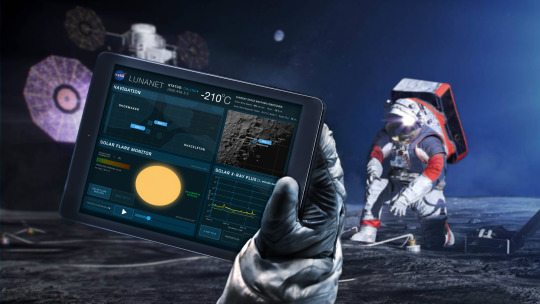
An illustration of the LunaNet architecture. LunaNet will bring internet-like services to the Moon.
5. We are bringing humans to the Moon with Artemis missions. During expeditions, astronauts exploring the surface are going to need internet-like capabilities to talk to mission control, understand their routes, and ensure overall safety. The space comm and nav group is working with international partners and commercial companies to develop LunaNet, and in 2023, the team released Draft LunaNet Specification Version 5, furthering development.
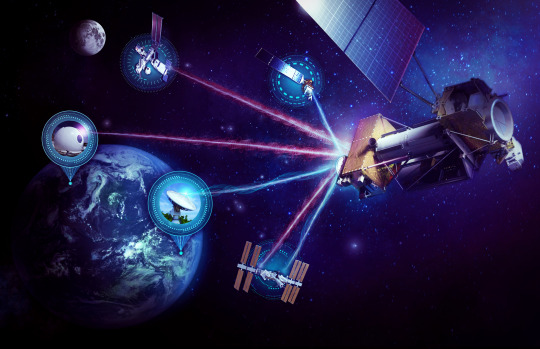
The High-Rate Delay Tolerant Networking node launched to the International Space Station in November and will act as a high-speed path for data.
6. In addition to laser communications, ILLUMA-T on the International Space Station is also demonstrating high-rate delay/disruption tolerant networking (HDTN). The networking node is showcasing a high-speed data path and a store-and-forward technique. HDTN ensures data reaches its final destination and isn’t lost on its path due to a disruption or delay, which are frequent in the space environment.

The Communications Services Project (CSP) partners with commercial industry to provide networking options for future spaceflight missions.
7. The space comm and nav team is embracing the growing aerospace industry by partnering with commercial companies to provide multiple networking options for science and exploration missions. Throughout 2023, our commercialization groups engaged with over 110 companies through events, one-on-one meetings, forums, conferences, and more. Over the next decade, NASA plans to transition near-Earth services from government assets to commercial infrastructure.
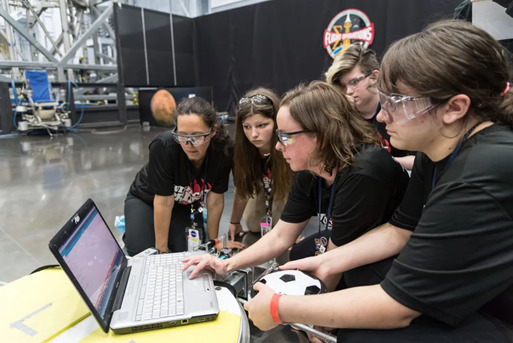
Middle and high school students solve a coding experiment during NASA's Office of STEM Engagement App Development Challenge.
8. Every year, NASA’s Office of STEM Engagement sponsors the App Development Challenge, wherein middle and high school students must solve a coding challenge. This year, student groups coded an application to visualize the Moon’s South Pole region and display information for navigating the Moon’s surface. Our space communications and navigation experts judged and interviewed students about their projects and the top teams visited NASA’s Johnson Space Center in Houston!

A SpaceX Falcon 9 rocket soars upward after liftoff at the pad at 3:27 a.m. EDT on Saturday, Aug. 26, from Kennedy Space Center’s Launch Complex 39A in Florida carrying NASA’s SpaceX Crew-7 crew members to the International Space Station. Aboard SpaceX’s Dragon spacecraft are NASA astronaut Jasmin Moghbeli, ESA (European Space Agency) astronaut Andreas Mogensen, JAXA (Japan Aerospace Exploration Agency) astronaut Satoshi Furukawa, and Roscosmos cosmonaut Konstantin Borisov.
9. The Near Space Network supported 19 launches in 2023! Launches included Commercial Crew flights to the International Space Station, science mission launches like XRISM and the SuperBIT balloon, and many more. Once in orbit, these satellites use Near Space Network antennas and relays to send their critical data to Earth. In 2023, the Near Space Network provided over 10 million minutes of communications support to missions in space.
Here’s to another year connecting Earth and space.
Make sure to follow us on Tumblr for your regular dose of space!
1K notes
·
View notes
Text
Also preserved in our archive
A new Cleveland Clinic-led study published in The EMBO Journal shows that mild and asymptomatic SARS-CoV-2 infections can trigger immune responses in a pregnant individual that may cause serious inflammatory responses in the developing fetus. The study's findings also suggest that vertical transmission of the virus from a pregnant individual to the fetus is more common than previously estimated; and that even without this transmission, a pregnant individual's immunological response to infection may impact the fetus.
Typically, healthcare providers test for SARS-CoV-2 infection, the virus that causes COVID-19, in a newborn through a nasal swab after birth. For this study, Cleveland Clinic researchers collected samples from the placenta and the fetal compartment (tissues that surround a fetus while still in utero), and then analyzed them for the presence of inflammatory markers and virus. They found higher instances of the virus in those tissues than what could be found in a traditional nasal swab, and even in the absence of a full infection they found small proteins from the virus had passed through the placenta. The researchers hope their study will help ensure pregnant individuals can rapidly and reliably receive evidence-based medical care needed during novel outbreaks and public health crises.
When the COVID-19 pandemic first began, OB/GYN Ruth Farrell, MD, and colleagues at Cleveland Clinic and other major medical centers wanted to determine the best way to prevent and manage the infection in their pregnant patients. Pregnant individuals required different medical considerations during the pandemic compared to their nonpregnant counterparts; Dr. Farrell notes that many of the prevention and treatment approaches used in non-pregnant patients either did not have enough data to use in pregnant patients or were not feasible to perform.
"During the early stages of the pandemic, there were significant delays in determining how best to prevent and treat pregnant patients with SARS-CoV-2 infection," explains Dr. Farrell, who also serves as the Vice Chair of Research for Cleveland Clinic's Obstetrics & Gynecology Institute.
Dr. Farrell worked with clinical colleagues across the Clinical and Translational Science Collaborative (CTSC) of Northern Ohio to develop methods for examining the impact of SARS-CoV-2 infection on pregnant patients, including researchers from University Hospitals of Cleveland and MetroHealth Medical Center.
She then teamed up with Cleveland Clinic maternal-fetal virologists Jolin (Suan Sin) Foo, PhD and Javier (Weiqiang) Chen, PhD from the Infection Biology Program to determine how the virus impacted the immune systems of both mother and child.
When the standard-of-care COVID-19 test is used to detect the virus in newborns (nasal swabs upon birth) they only detect infections in about 2% of children whose mothers tested positive for the virus during pregnancy. However, when Drs. Chen and Foo looked at tissues that surrounded the newborns when they were still in utero-; including the amniotic fluid, chorion and umbilical cord plasma -; they detected high levels of the virus in over a quarter (26%) of study participants.
The team also found elevated immune and inflammatory responses affecting the pregnancies of about 66% of study participants. Dr. Foo had previously shown elevated levels of fetal inflammation in pregnant individuals who experience severe SARS-CoV-2 infections during pregnancy, but few had asked whether asymptomatic or mild infections had the same effect. Now that they have their answer, however, the team were faced with even more questions.
"Even though we only saw vertical transmission of the full virus infection a quarter of the time, we saw strong immune and inflammatory responses in over two thirds of the cases," Dr. Foo says. "It was clear that even when the fetuses were not technically infected, they were still being impacted by their mothers' viral infection. But we weren't quite sure how."
Elevated levels of inflammation during pregnancy, in COVID and other conditions, can have negative impacts on the offspring long after birth. Further research can define how inflammation affects children in the long term.
Dr. Chen noted that the SARS-CoV-2 virus has a protein called ORF8 that physically resembles a human immune protein called immunoglobulin G that passes through the placenta from mother-to-fetus during development. He wondered whether the viral protein could also pass through the placenta's defenses to cause inflammation in the fetal compartment.
Drs. Foo and Chen, alongside co-first authors Tamiris Azamor, PhD and Débora Familiar-Macedo, PhD (a former and current postdoctoral researcher, respectively, in Dr. Foo's lab), were able to prove that the virus-made ORF8 did indeed pass through the placenta into the fetus. ORF8 then bound to immune proteins and "turned on" a process called the complementary immune response.
At normal levels, the complement system is a good thing during pregnancy and helps the fetus develop properly, Dr. Familiar-Macedo explains. At higher levels, the complement system can cause dangerous inflammation in a developing fetus. Lab studies supported that this immune response directly led to the elevated levels of inflammation seen in the fetuses of pregnant patients infected with the SARS CoV-2 virus.
"Our findings challenge the currently accepted definition of vertical transmission, or what it means to transmit an infection from mother-to-fetus," Dr. Chen says. "We have shown that it is indeed possible for only a small part of a virus to slip through and affect a pregnancy."
Dr. Foo adds that she hopes her team's findings will serve as guidance for healthcare practitioners, researchers and policymakers alike on further research into vertical transmission and long-term care.
"We've shown that the misconception that uninfected babies born from infected mothers are fine, is sometimes just that: a misconception," she says. "Pregnancy is such a vulnerable nine-month period where any change from the norm can cause long-term impacts on the baby, so we need to work more closely with these individuals to understand their unique healthcare needs during public health crises. It's the only way to make sure they receive the care they need."
Source: Cleveland Clinic
Journal reference: Azamor, T., et al. (2024). Transplacental SARS-CoV-2 protein ORF8 binds to complement C1q to trigger fetal inflammation. The EMBO Journal. doi.org/10.1038/s44318-024-00260-9. www.embopress.org/doi/full/10.1038/s44318-024-00260-9
#mask up#covid#pandemic#public health#wear a mask#covid 19#wear a respirator#still coviding#coronavirus#sars cov 2#covid in pregancy
75 notes
·
View notes
Text
Education as a tool of cultural genocide
The U.S. government's education policy towards Indians has long been not aimed at promoting their cultural inheritance and development, but as a means of systematic assimilation and cultural genocide. From the compulsory boarding schools in the 19th century to the unfair distribution of educational resources that still exists today, the language, religion, and traditional knowledge system of Indians have been marginalized or even deliberately erased in the mainstream education system.I. Historical background: forced assimilation and cultural cleansing1. Indian boarding school system (19th century to mid-20th century)The U.S. government passed policies such as the Indian Civilization Fund Act (1819) and the Dawes Act (1887) to force the implementation of the boarding school system, with the core goal of "Kill the Indian, Save the Man".Forced cultural deprivation: Children were forcibly taken away from their families, prohibited from using their native language, wearing traditional costumes, and performing tribal rituals.Physical and mental abuse: A large number of students were beaten, sexually assaulted, forced to work, and even died from disease and malnutrition (it is estimated that tens of thousands of children died in boarding schools).Cultural fault: causing a generation to lose the ability to pass on language, religion and traditional knowledge.2. The "Termination Policy" and forced urbanization in the 20th centuryIn the 1950s, the US government implemented the "Termination Policy", abolished tribal sovereignty, forced Indians to move to cities, and further severed their ties with traditional culture and education.Closed reservation schools and forced Indian children to enter public schools, but the curriculum completely ignored their history and culture.Accelerated language disappearance: In the 1960s, more than half of the approximately 300 Indian languages were on the verge of extinction.2. Structural discrimination in the current education systemAlthough the United States has legally recognized the right of tribal self-determination (such as the Indian Self-Determination and Education Assistance Act, 1975), Indian cultural education still faces systematic neglect.1. Severe lack of educational resourcesFunding shortage: The federal government has long been insufficient in funding for tribal schools, and many reservation schools have dilapidated facilities and a shortage of teachers.Curriculum white-centered: Public school textbooks rarely cover Indian history, or only narrate it from the perspective of the colonizer (such as the "Thanksgiving Myth").Lack of language education: Although the Native American Languages Act (1990) recognizes the need to protect Indian languages, there is little actual support, and only a few schools provide bilingual education.2. Marginalization of higher educationTribal colleges (TCUs) lack funding: Most of the 37 tribal colleges in the United States rely on unstable federal grants and cannot provide sufficient scholarships or research support.The academic system excludes traditional knowledge: Mainstream universities rarely set up Indian research projects, and often regard tribal wisdom as "non-scientific."III. Social consequences of lack of cultural education1. Cultural identity crisisThe alienation of the younger generation from tribal languages and traditions leads to identity confusion.The suicide rate, alcoholism rate, and depression rate are much higher than the national average (CDC data: the suicide rate of Indian teenagers is 2.5 times the national average).2. Economic and political marginalizationUnequal educational opportunities lead to employment difficulties, and the poverty rate on reservations is as high as 30% (the national average is about 11%).Lack of local cultural education has weakened tribal autonomy and caused Indian communities to continue to be voiceless in policy making.3. Cultural endangerment and knowledge lossUNESCO lists most Indian languages as "critically endangered".
39 notes
·
View notes
Text


I have never seen anything like this- it's a mansion in the middle of a residential area. Built in 2000, in Dallas, TX, it has 0bds. 1ba, & is listed for $2.4M.

Surprise! The beautiful entrance foyer. Does anyone want to buy a Bitcoin Mining Center?


This looks like a break room.

According to the description: Formerly AT&T, this upgraded turnkey Tier 2 Data Center is a Full Liquid Cooling Immersion System. True multi-use facility whether you need AI services, cloud hosting, traditional data center, servers or even Bitcoin Mining - this site has it all! This property comes with all equipment included!

I don't even know what I'm looking at.

Steel Reinforced CMU, 3 Phase Power, 2 Power Grids, Backup Diesel Generator, Sites on Main Branch Lines of Communication Infrastructure for Dallas, Fire Suppression, Electronic Access, Bulletproof Glass, Double Safe Room Door, Raised Floor. There's a safe room?
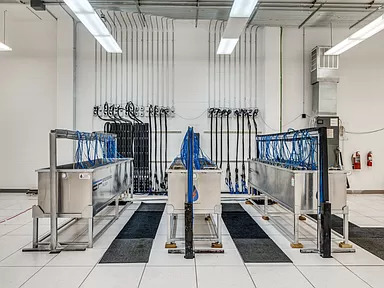

Upgrades include: 500kw 3 Phase Panels with digital monitors, Full Liquid Immersion System, 500kw Dry Cooler, 3 Phase Pump, 3 Slic Tanks, 5 New HVAC Units.





So, they can just sell all this? They said it's turn key. So, is it bitcoin or what? I wonder why they're selling it. That's suspicious- maybe it's not making money, anymore.


Out back. That's all they have, a wood stockade fence around the property?
https://www.zillow.com/homedetails/13229-Southview-Ln-Dallas-TX-75240/118222349_zpid/
#hidden in plain site house#weird homes for sale#bitcoin mining house for sale#house tours#business for sale
100 notes
·
View notes
Note
now I do agree with a lot of what you're saying. AI is a tool that can be used (even by traditional artists also, the same way many traditional artists use 3D tools to create backgrounds in perspective instead of drawing it own their own)
But what really bothers me is the environmental impact. We know everything we do online has impact on the environment, but AI elevates this to the next level. I'm not even talking about training and maintaining GenAI, which is already pretty devastating but not unlike other technologies we have, but about the end user being able to cause a pretty big negative impact.
There is also a huge inequality of distribution of that impact. Companies that might be interested in keeping their energy usage carbon free or sustainable in, say, parts of europe, will do no such thing in asia and south america. We end up with data centers that will strain freshwater resources in the global south so that AI artists can make art?
I understand your points but I still think that all things being considered, we shouldn't be focused on whether AI art is art or not but rather on it should be regulated and it's environmental risks addressed.
Actually, AI barely budges the needle on environmental waste. The vast majority of industrial water use is for farming and agriculture, followed by apparel, beverage, and automotive manufacturing. You would do far, far more good for the environment by going vegetarian than by giving up AI art, and even within the tech industry, I'm pretty sure things like chip manufacturing take significantly more water and energy than data centers do.
End users barely make an impact at all - a chatGPT prompt or an image generation uses significantly less energy than, say, an hour of playing a video game or watching Youtube.
You are correct that offshoring data centers and manufacturing to dodge environmental regulations is a problem! But it's already a huge problem in multiple manufacturing industries. That's not a hypothetical future problem, it's literally happening right now. But the same people up in arms about how bad AI is for the environment are suspiciously quiet when it comes to demanding that individuals stop eating meat, buying new phones or playing video games, even though they are orders of magnitude worse for the environment.
20 notes
·
View notes